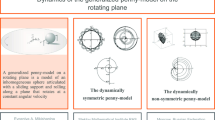Abstract
We investigate regular and chaotic dynamics of two bodies swinging on a rod, which differs from all the other mechanical analogies: depending on initial conditions, its oscillation could end very quickly and the reason is not a drag force or energy loss. We use various tools to analyze motion, such as Poincaré section for quasi-periodic and chaotic cases. We calculate Lyapunov characteristic exponent by different methods including Finite Time Lyapunov Exponent analysis. Our calculations show that the maximal Lyapunov exponent is always positive except in the marginal cases when one observes quasi-periodic oscillations.
Graphic abstract







Similar content being viewed by others
Data availability
The datasets generated during and/or analysed during the current study are available from the corresponding author on reasonable request.
References
H. Poincaré, Mémoire sur les courbes définies par une équation différentielle (I). Journal de Mathatiques Pures et Appliquées 7, 375 (1881)
I. Bendixson, Sur les courbes définies par des équations différentielles, Acta Mathematica, vol. 24. (Springer, Heidelberg, 1901), p.1
P. Gaspard, Chaos and hydrodynamics. Phys. A 240, 54 (1997)
J. Petrzela, Z. Hrubos, T. Gottans, Modeling deterministic chaos using electronic circuits. Radioengineering 20, 438 (2011)
T. Devolder et al., Chaos in magnetic nanocontact vortex oscillators. Phys. Rev. Lett. 123, 147701 (2019)
E. Ott, Chaos in dynamical systems (University of Maryland, College Park, 1993)
D. Acheson, From calculus to chaos: an introduction to dynamics (Jesus College, Oxford, 1997)
G. Khomeriki, Parametric resonance induced chaos in magnetic damped driven pendulum. Phys. Lett. A 380, 2382 (2016)
H.N. Huynh, L.Y. Chew, Two-coupled pendulum system: bifurcation, chaos and the potential landscape approach. Int. J. Bifurcat. Chaos 20, 2427 (2010)
H. huynh, T. Nguyen, L. Chew, Numerical simulation and geometrical analysis on the onset of chaos in a system of two coupled pendulums. Commun. Nonlinear Sci. Numer. Simulat. 18, 291 (2013)
K. Polczyn, A. Wijata, J. Awrejcewicz G. Wasilewski, Numerical and experimental study of dynamics of two pendulums under a magnetic field. Syst. Control Eng. 233, 441 (2019)
J. Awrejcewicz. G. Kudra, G. Wasilewski, Experimental and numerical investigation of chaotic regions in the triple physical pendulum. Nonlinear Dyn. 50, 755 (2015)
H. Suetani, K. Soejima, R. Matsuoka, U. Parlitz, H. Hata, Manifold learning approach for chaos in the dripping faucet. Phys. Rev. E 86, 036209 (2012)
H.J. Hubbard, The forced damped pendulum: chaos, complication and control. Am. Math. Mon. 106, 741 (2019)
N. Kudryashev, The generalized Duffing oscillator. Commun. Nonlinear Sci. Numer. Simul. 93, 105526 (2021)
T. Stachowiak, T. Okada, A numerical analysis of chaos in the double pendulum. Elsevier 29, 4172437 (2006)
T. Stachowiak, T. Okada, A numerical analysis of chaos in the double pendulum. Chaos Solit. Fract. 29, 417 (2006)
T. Shinbrot, C. Grebogi, J. Wisdom, J.A. Yorke, Chaos in a double pendulum. Am. J. Phys. 60, 491 (1992)
Y. Lai, T. Tel, Transient chaos (2011)
G. Haller, Distinguished material surfaces and coherent structures in 3d fluid flows. Phys. D 149, 248 (2001)
C. Manchein, M.W. Beims, J.M. Rost, Characterizing the dynamics of higher dimensional nonintegrable conservative, systems. Chaos Interdiscip. J. Nonlinear Sci. 22, 033137 (2012)
C. Manchein, M.W. Beims, J.M. Rost, Characterizing weak chaos in nonintegrable Hamiltonian systems: the fundamental role of stickiness and initial conditions. Phys. A 400 (2014)
S. Sabarathinam, K. Thamilmanar, Transient chaos in a globally coupled system of nearly conservative Hamiltonian Duffing oscillators, Chaos, Solitons & Fractals, 73 (2015)
D.R. Gonzalez, R.L. Speth, D.V. Gaitonde, M.J. Lewis, Finite-time Lyapunov exponent-based analysis for compressible flows. Chaos 26, 083112 (2016)
F. Lekien, S.D. Ross, The computation of finite-time Lyapunov exponents on unstructured meshes and for non-Euclidean manifolds. Chaos 20, 017505 (2010)
D. Garaboa-Paz, J. Eiras-Barca, F. Huhn, V. Perez-Munuzuri, Lagrangian coherent structures along atmospheric rivers. Chaos 25, 063105 (2015)
S.C. Shadden, J.O. Dabiri, J.E. Marsden, Lagrangian analysis of fluid transport in empirical vortex ring flows. Phys. Fluids 18, 047105 (2006)
M.A. Green, C.W. Rowley, A.J. Smits, Using hyperbolic Lagrangian coherent structures to investigate vortices in bioinspired fluid flows. Chaos 20, 017510 (2010)
T. Tel, M. Gruiz Chaotic dynamics: an introduction based on classical mechanics. Cambridge university (2006)
E.M.A.M. Mendes , E.G. Nepomuceno, A very simple method to calculate the (positive) largest Lyapunov’s Exponent using interval extensions. Int. J. Bifurcat. Chaos 26 (2016)
A. Wolf, J.B. Swift, H.L. Swinney, J.A. Vastano, Determining Lyapunov’s exponents from a time series. Phys. D 16, 285 (1985)
M.T. Rosenstein, J.J. Collins, C.J. De Luca, A practical method for calculating largest Lyapunov exponents from small data sets. Phys. D 65, 117 (1993)
Acknowledgements
We would like to thank T. Gachechiladze, G. Bakhtadze, G. Khomeriki and M. Osmanov-Baisera for interesting discussions and valuable comments.
Author information
Authors and Affiliations
Contributions
LO contributed in setting general idea and implementation its numerical simulations as well as in writing manuscript draft. RK participated in choosing the methods for problem treatment and presentation of the simulation results as well as writing the paper draft.
Corresponding author
Rights and permissions
Springer Nature or its licensor (e.g. a society or other partner) holds exclusive rights to this article under a publishing agreement with the author(s) or other rightsholder(s); author self-archiving of the accepted manuscript version of this article is solely governed by the terms of such publishing agreement and applicable law.
About this article
Cite this article
Osmanov, L., Khomeriki, R. Regular and chaotic motion of two bodies swinging on a rod. Eur. Phys. J. B 95, 182 (2022). https://doi.org/10.1140/epjb/s10051-022-00435-5
Received:
Accepted:
Published:
DOI: https://doi.org/10.1140/epjb/s10051-022-00435-5



